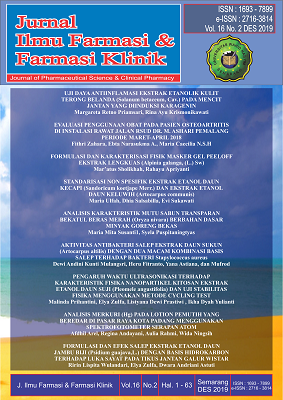Main Article Content
Abstract
ABSTRACT
Osteoarthritis (OA) is a degenerative joint illness characterized by cartilage destruction and
often found on older people. The drugs commonly used to treat OA symptoms is paracetamol,
nonsteroidal anti-inflammatory drugs (NSAIDs), food supplements such as glucosamine and
chondroitin. The purposes of these studies are identifying the OA patient's characteristics
(including gender and age), drug use evaluation based on the right patient, indication, and dose, as
well as the potency of drug interactions on OA patients. This research is non-experimental
research with a non-analytical descriptive design. The data was collected retrospectively with a
purposive sampling method from outpatients OA medical records in RSUD Dr. M. Ashari
Pemalang (March to April 2018 period). The results of this study indicate that patients have
suffered OA for 1-2 years (40%), generally women (72.94%) with an age range of 46-55 years
(39%). Most patients have an elementary school educational background (41%), and 43.53% of
them are overweight (BMI 25.00-29.99). All medicines prescribed for OA patient therapy have
been the right indication and patient. As many as 80.95% of the prescribed medicines had the right
dose, and 19.05% of prescription drugs case categorized as underdosing. Drug interactions
potency occurs in 30.58% of patients, with 29 cases.
Keywords: Osteoarthritis, drugs use evaluation, outpatient
Osteoarthritis (OA) is a degenerative joint illness characterized by cartilage destruction and
often found on older people. The drugs commonly used to treat OA symptoms is paracetamol,
nonsteroidal anti-inflammatory drugs (NSAIDs), food supplements such as glucosamine and
chondroitin. The purposes of these studies are identifying the OA patient's characteristics
(including gender and age), drug use evaluation based on the right patient, indication, and dose, as
well as the potency of drug interactions on OA patients. This research is non-experimental
research with a non-analytical descriptive design. The data was collected retrospectively with a
purposive sampling method from outpatients OA medical records in RSUD Dr. M. Ashari
Pemalang (March to April 2018 period). The results of this study indicate that patients have
suffered OA for 1-2 years (40%), generally women (72.94%) with an age range of 46-55 years
(39%). Most patients have an elementary school educational background (41%), and 43.53% of
them are overweight (BMI 25.00-29.99). All medicines prescribed for OA patient therapy have
been the right indication and patient. As many as 80.95% of the prescribed medicines had the right
dose, and 19.05% of prescription drugs case categorized as underdosing. Drug interactions
potency occurs in 30.58% of patients, with 29 cases.
Keywords: Osteoarthritis, drugs use evaluation, outpatient
